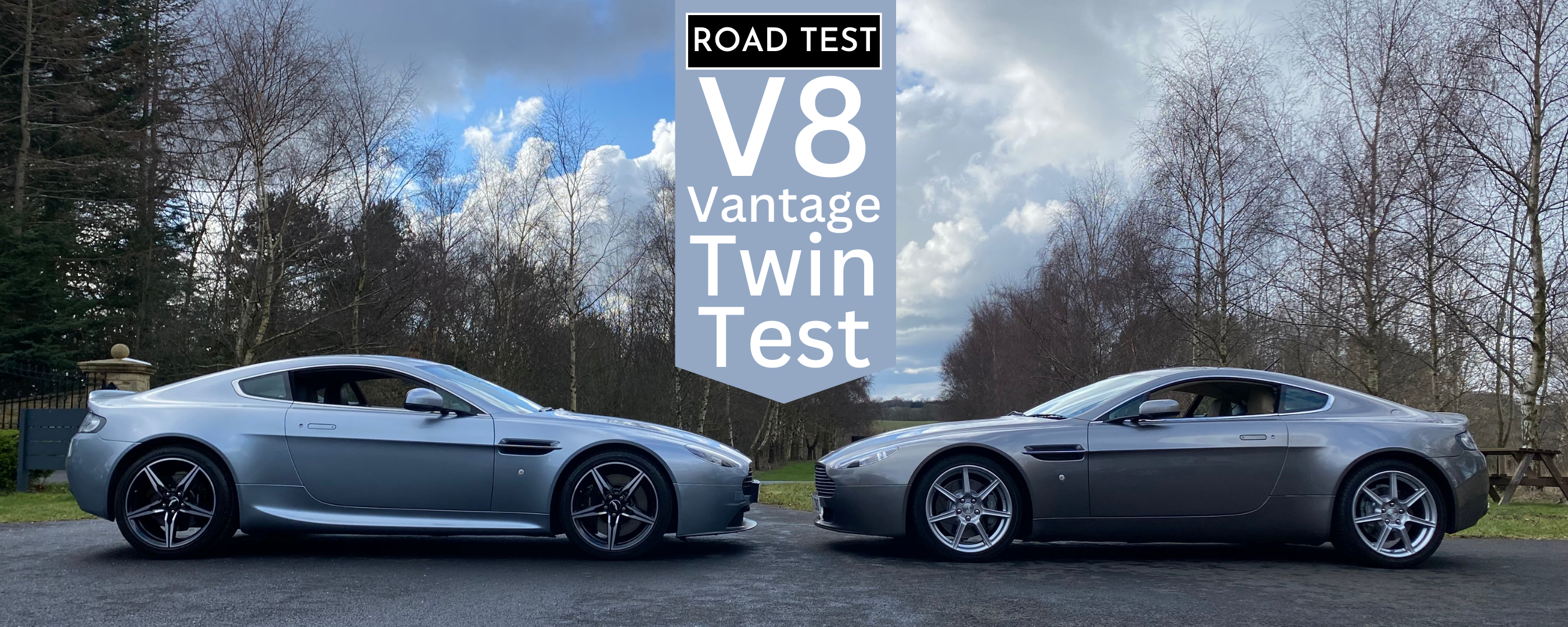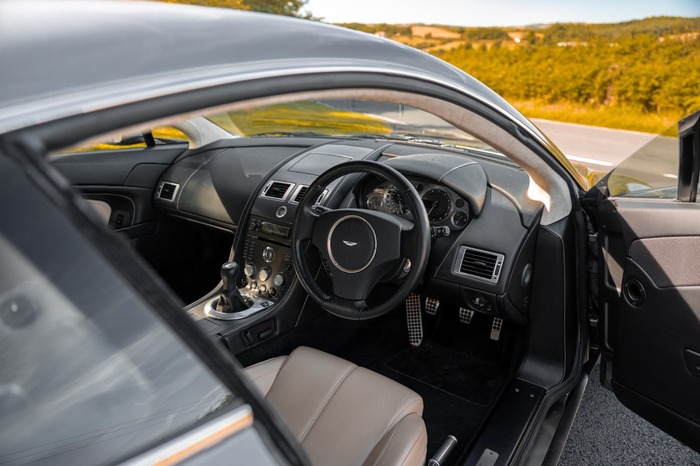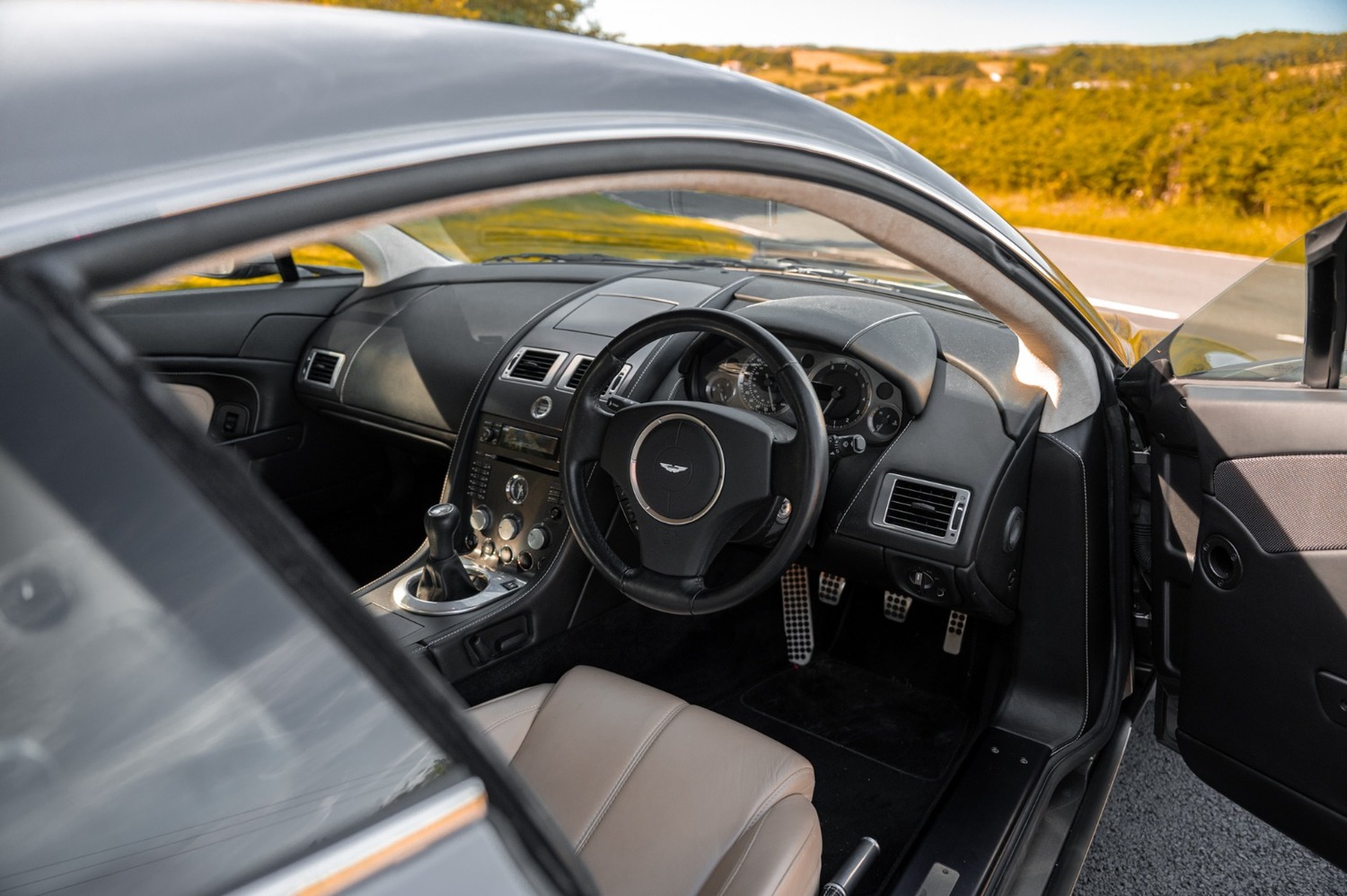Aston Martin V8 Vantage Twin Test
31 March 2023
Vantage. More than maybe other nameplate in Aston Martin’s history, Vantage signifies something special. Traditionally reserved for limited-number, high-power variants of Astons range-topping GTs, the Vantage badge had its second coming in 2005 when a name was needed for the brand-new Aston Martin 2-seater. Designed to take the fight to the Porsche 911 in the sports car market Vantage was just as special as its predecessors, featuring an Aston Martin designed variant of Jaguars AJ-V8 engine producing 380bhp in launch spec.
The V8 Vantage came about as a late 90s project to create two new cars: A 2+2 Grand Tourer to replace the DB7 and a smaller 2-seater model to become Astons new sports car. Ian Callum, Aston Martin Director of Design at the time, was tasked with putting a design together for the latter and came up with AM305, a mid-engined, 2-seater Aston Martin which looked to update Astons classic styling for the 21st century. The concept was well received internally, and is rumoured to have been greenlit by parent company Ford, however new CEO Dr Ulrich Bez cancelled the project as his first official act believing Aston should stick to front-engined cars.
The company changed direction, with the smaller car becoming front-engined and development funds spent on a new “Vertical-Horizontal” chassis architecture that could be used for multiple models in the Aston Martin range. VH allowed Aston to go on to build the DB9, DBS, Virage, Vanquish and Rapide models keeping the same core chassis design, contributing greatly to Aston’s improved fortunes in the new millennium. The AMV8 Vantage concept unveiled at the 2003 Detroit Motor Show previewed this new era of Aston Martin design and was an immediate hit, translating almost exactly to the production V8 Vantage.
All that history brings us to these two cars. The first is a 2007 car, featuring the earlier 4.3L engine mated to a six-speed manual gearbox, while the second is a 2016 4.7L example with Aston’s second generation Sportshift transmission. Both are low mileage, high specification cars, yet with nearly a decade between them look to offer quite different experiences. The early car represents the very first version of V8 Vantage, before engine enlargements and chassis upgrades turned the Vantage into the later car that it’s up against.
In Tungsten Silver Metallic over a Sandstorm interior, the 4.3L car feels classic Aston Martin. The Callum/Fisker design is shown in its purest form, with a timeless simplicity that doesn’t need sharp angles and crazy false aero devices to be aggressive. The term “Brute in a Suit” is often applied to Astons, and it’s an apt description here. The design borrows heavily from the DB9 that came from the same two designers, however with slightly tweaked proportions. The Vantage is both shorter and narrower than the DB9, but the most of the length is taken from the front and rear overhangs giving the Vantage a more compact, purposeful look.
Climb into the car and the first impression is familiarity. The overall shape and feel of the interior is very ‘21st Century Aston Martin’ with the central waterfall feature a mainstay of almost every model made this side of the DB7. Touchpoints feel high quality; the steering wheel looks a little visually bulky but it’s the right size and shape in the hands, and the Aston Martin engineers did a fantastic job of integrating switchgear from sister-brand Volvo into the Vantage interior. There is a nice weightiness to everything, even extending to the comically thin sun visor found on all VH era cars.
Push the glass Start button (early Vantages use traditional keys for ignition rather than the later glass ECU keys) and the V8 fires up. It’s almost universally accepted that the sound of a V8 engine is one of life’s pleasures, and the Aston Martin unit doesn’t disappoint. There’s a gravelly note to it as it burbles on idle, and it’s impossible to resist a quick stab on the throttle as a self-indulgent treat. This car is fitted with the AMR twin clutch and flywheel upgrade, and the effects are felt straight away. V8 Vantages are often accused of having a slightly heavy clutch, but here the weighting of all controls feels appropriate and well matched.
Slipping the 6-speed into manual and pulling away, the car inspires confidence; this isn’t a wild, angry beast to be tamed like the AMG-engined ‘Second Century’ Vantage, chomping at the bit to surpass the speed limit. At slow speeds the V8 Vantage is easy to manoeuvre, with the small overall footprint intuitive to place amongst its surroundings. Pulling out onto the start of the Aston Workshop test route it becomes clear this is a very well damped car, not sacrificing Aston’s reputation for good ride quality. The 380bhp is more than manageable, suitable for the kind of sedate around-town driving that makes Vantage a genuine daily-driver Aston Martin, but putting the foot down serves of a reminder of how potent this car can be.
Climb through the gears from a standstill and the engine note encourages use of the full rev-range. The lightened flywheel adds some extra liveliness to the V8 while the AMR twin plate clutch comes into its own on those snappy upshifts while climbing up to 60mph. The 275 section rear tyres do a fine job of keeping things under control, allowing the Vantage’s limits to be fully explored without fear of driving talent very quickly running out. The V8 Vantage has often been nicknamed the ‘Baby-Aston’ which seems quite suitable on this car. The chassis has a definite lean towards comfort, and its’ clear this car has been built by people who have a reputation building the world’s finest Grand Tourers. Against its competitors from the likes of Porsche with the 911, Vantage trades the upper limits of sporting dynamics for improved usability and comfort. This is a mini-GT as much as it’s an out-an-out sports car, and is all the better for it.
Fast forward nine years and the standard V8 Vantage is nearing the end of production. The later car we have here is one of the final made in standard ‘non-S’ form, with a 0.4L larger capacity producing an extra 40bhp over the original V8 Vantage. Externally the design is familiar yet subtly updated. At the front the new front bumper features a prominent chin spoiler below a larger lower air intake. The side sills are borrowed from the V8 S, albeit slightly less aggressive with a noticeable upsweep at the rear. The smooth, body colour rear bumper of the earlier car is replaced by a black, cut-out version.
It's a similar story inside; the core design is similar but there are subtle improvements. The switchgear is now all custom for Aston Martin, with the waterfall dash now studded with haptic buttons shared with the rest of the Aston range. The steering wheel stays the same shape, now looking a little dated against the updated interior, but with perforated leather to add a more modern touch. The seats remain the same, however the centre console is subtly updated with improved storage. N wholesale changes have been made, which is no bad thing given the sensible and high-quality original design.
Where there is a noticeable change is the introduction of the ‘Emotional Control Unit’. The ECU, a small heavy glass key, replaces the traditional key. Fairly controversial at the time, and now replaced by Mercedes-sourced wireless keys, the ECU is actually a fairly novel concept that feels high quality and, dare say it, a little fun as well. Slot the glass key into the dash and push to start the V8, and a more raucous and aggressive fire-up note explodes from the engine bay. The late V8 Vantages share many of the improvements found in the more expensive ‘S’ models, including a new exhaust which is more outwardly racy than the early cars.
The steering is a combination of weightier and quicker, encouraging a sportier driving style. While the impressive damping of the original design remains, this Vantage is a little more firmly sprung and a touch more mobile on the initial bumpy section of the Aston Workshop test route. It’s still a very compliant ride, with Aston staying true to their reputation for comfort. The second generation Sportshift ‘box is a clear improvement over the original, but the laziness in auto mode still lets it down compared to a traditional manual. With time it’s quite easy to adapt to the Sportshift system, and switching over to manual mode turns it into a far more enjoyable experience.
Flicking through the ratios using the paddles brings the best out of the raucous V8, turning the car into a B-road destroyer. Just as the auto mode shouldn’t be driven like a traditional auto, the manual mode differs from a modern dual-clutch paddle transmission; lifting for the up-shifts rather than staying on the throttle negates all of the laziness the Sportshift transmission has a reputation for. On the more interesting bits of road the firmer suspension and quicker steering allow the car to be thrown about a bit more, while the larger 380mm front discs and 6-piston calipers stop anything from going too far.
So after comparing both cars, what are we left with? The 4.3L engine on the older car requires a little more work to extract its performance but paired with a manual gearbox that’s no hardship. Working through the gears is where the fun comes from in the car, with the AMR clutch and flywheel heightening the whole experience. A supple ride and signature V8 engine note contribute to the overall experience of the V8 Vantage, which for many people is the reason for ownership. Low mileage 4.3L Vantages are hard to find these days, with the sheer usability they offer making them daily-Astons for most owners.
The 2016 Vantage seems to take its sports-car responsibilities a little more seriously than its older brother, at the slight expense of being a firmer ride. As a car to be thrown around B-roads rather than enjoyed at a more leisurely pace the later car is probably the best choice, and the second-gen Sportshift transmission can be very rewarding once the manual mode is mastered. The improvement in power, handling and interior technology comes with a cost premium, but as time goes on and more new-shape Vantages are sold that price-gap should shrink.
Ultimately the decision between which to buy is down to each individual owner and what they’re wanting from their Vantage, but what remains true to both cars is that the design is sure to be a classic. The smallest Aston has a genuine claim to being the best, with a timeless shape and true drivers-car characteristics. With a reputation for being a fantastic first Aston Martin due to reasonable second-hand values, it’s no wonder the V8 Vantage is held in such high regard. To see our current range of Vantages for sale, click here.


















